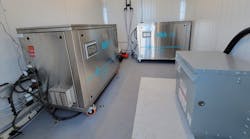Answers
1. d. Water contact plumbing and housings made of stainless steel and utilized for seawater or water sources whose chloride concentration will exceed several thousand milligrams per liter in RO concentrate, should utilize 316L grade stainless steel. With 316L, there will be reduced possibility of corrosion, particularly around welds. The cost of the 316L stainless will be slightly higher than standard 304 or 304L grade stainless steel. The “L” signifies lower carbon content (i.e., 3 percent maximum) and 316 stainless contains a higher amount of nickel, which is especially resistant to corrosion in a high chloride environment and which also helps further prevent chromium carbide precipitation, which can deplete the alloy of some chromium in the area of welds and thereby also lower its corrosion resistance.
2. d. The weight of a mole of a particular element or compound depends on the number of protons and neutrons in its nucleus, and is called its molecular weight expressed as grams per mole. It has been determined that 6.02 x 1023 (Avogadro’s number) of protons and/or neutrons weigh 1 gram. There exists this same number of molecules in a gram-molecular weight or mole of any substance, i.e., 6.02 x 1023 H2O molecules in 18 grams of water.
3. a. Certain elements such as iron, manganese or copper can change their valence states in an oxidation/reduction reaction. This ability allows the metals to act as a catalyst to increase the rate of local oxidation, cased by an oxidizing agent, such as chlorine, around any metal particles deposited on membrane or resin media surfaces. The ability of transition metals to increase the oxidation potential of oxidizers occurs because after such oxidized metals precipitate on a membrane or resin surface they can again take one or more electrons into the outer valence shell of their atoms (becoming chemically reduced). When free chlorine, for example, is present around this environment, it can more aggressively steal electrons from the membrane or resin (i.e., oxidize and breakdown the membrane or resin).
4. d. Different salts contribute different osmotic pressures, for example, the osmotic pressure of sodium chloride is about 1.15 psi for each 100 mg/L of NaCl; it is about 0.6 psi for each mg/L of Na2SO4. But, for most drinking water and pure water applications the natural osmotic pressure can be estimated for the combined salt content of the water by multiplying the TDS by 1 psi per 100 mg/L or by 0.01 psi per mg/L of TDS differential across the membrane.
5. b. An RO system permeate recovery is defined as the ratio of permeate flow to feed water flow. It is often simply called system "recovery," and can be expressed as a fraction or more commonly as a percentage.
6. a. For example, given an RO system operating at 30 percent recovery and with a feed water containing 1,200 mg/L of TDS, the TDS of the reject water would be about 1,200 divided by (1 – 0.30) = 1,714 mg/L.
7. c. From #6 above, the feed water contains 1,200 mg/L of TDS and the reject water would contain 1,714 mg/L of TDS. Therefore, the average feed water/concentrate TDS would be: (1,200 mg/L + 1,714 mg/L) divided by 2 = 1,457 mg/L. And the average osmotic pressure would be 1,457 mg/L x 0.01 psi per mg/L = 14.57 or 15 psi.
8. b. Salts made up of ions with the higher valence numbers (larger electrical charge values) and those that most completely ionize in water will tend to have higher rejection by and lower passage through RO membranes. For example, compared to sodium chloride, calcium sulfate will pass through an RO membrane only one-third as well, magnesium bicarbonate about six-tenths as well, but sodium nitrate about five times better.
9. b.
10. a. Because RO membranes reject bicarbonate ions, which tend to buffer or raise the pH of water, and at the same time membranes allow ready passage of dissolved gases such as carbon dioxide, which form acids in water, the concentrate stream almost always experiences an elevation in pH and the permeate stream a lowering of pH. The higher pH of the concentrate stream, if not controlled or accounted for, can contribute to increased precipitation and membrane fouling by inorganic solutes such as calcium sulfate and calcium carbonate, and it may also exacerbate destructive hydrolysis in cellulosic membranes. Lower pH may increase the acid corrosivity of RO permeate, but the absence of buffering compounds in low TDS RO permeate means this pH intensity is usually very temporary and can be readily changed.

